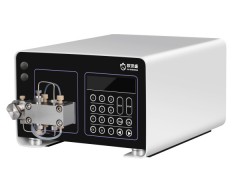KRI 考夫曼離子源 Shift-Free Optical Coatings (Staff of Vacuum Innovations LLC )
INTRODUCTION
The deposition of optical interference coatings requires precise control of layer thicknesses and refractive indices in order to yield predictable, reliable performance. One of the challenges in the use of evaporated coatings is the porous ?lm structure and the associated sensitivity to relative humidity and temperature which results from the low energy of the deposited molecules [1,2].
The use of an End-Hall ion source can provide added energy at the surface of the condensing ?lm, resulting in a denser ?lm structure for the coating molecules [3]. This denser structure can reduce or eliminate the penetration of water into the ?lm, thereby limiting the change in refractive index and other optical parameters in the coating. This densi? cation also provides a harder, more mechanically-durable ?lm, even at low deposition temperatures [3].
SYSTEM ConFIGURATION
A typical system for optical interference coating deposition consists of a 0.5 1.5m vacuum chamber with planetary or single substrate rotation and one or more evaporation sources, as shown in Fig. 1. The system geometry should be arranged to provide nearly equal coating thickness on all substrates, or masks should be introduced to partially shadow regions of higher vapor ? ux [4].
The addition of an End-Hall ion source should be con?gured such that nearly-equal ion ?ux is provided to the entire substrate surface area in the coating chamber, while maximizing the utilization of the available ion ?ux. The modeling of ion ?ux with a cosine-power distribution is discussed in KRI Technical Report TR-01. The placement of the source in the chamber and the tilt of the source from vertical provide the necessary adjustments to evenly distribute ion ? ux. The determination of ion ?ux uniformity requires the modeling of the substrate movement, source placement and pointing using a cosine-power distribution for the ion source ?ux and rotation motion for the substrate [4]. An approximate starting point is to place the source directly beneath the center of the planet and direct the source at the inner edge of the annulus described by the planet motion (see Fig.1).
ION SOURCE PARAMETERS
Successful densi?cation of oxide materials for optical interference coatings requires operation at low ion energies and high current. Energies on the order of 100eV avoid the formation of crystallites and minimize gas incorporation,
Fig.1-Deposition chamber con?guration
though the use of slightly higher ion energies (up to 150eV) may be required to achieve the desired degree of densi?cation [5].
Development of ion-assisted deposition requires knowledge of the process variables, and the in?uence of each on the resulting ?lm properties. These include the ion energy, current, gases to be used, gas ?ow rates, and the ?lm deposition rate.
Ion Energy
The discharge voltage determines the ion energy (eV), by establishing the potential difference through which the ions are accelerated. On an End-Hall ion source the ion energy corresponds to approximately 60% of the discharge voltage. High discharge voltages provide greater ion energies, but can increase optical absorption and defect densities. The lowest possible discharge voltage should be utilized that achieves the desired ? lm densi?cation, usually less than about 150V.
Ion Beam Current
The ion-beam current corresponds to about 20% of the discharge current in an End-Hall ion source. An ion beam current higher than necessary is generally not a problem [5], though the presence of a highly nonuniform distribution of ion dose may lead to signi?cant variation in ? lm densi?cation. A key advantage of End-Hall ion sources is the availability of high beam currents. The densi?cation of hafnium dioxide deposited over large-area substrates in a 1.1m box coater can
Densified Hafnium Dioxide Densified Hafnium Dioxide / Silicon Dioxide Mirror Densi?ed Hafnium Dioxide Densi?ed Hafnium Dioxide /Silicon Dioxide Mirror
Fig.3- In?uence of humidity on a 9-layer hafnia/silica mirror deposited at ambient temperature with ion-assist provided by the KRI eH3000. once again, the difference between the ?lm transmittance in ambient and dry envirnments cannot be resolved (fully dense).
for production throughput, while minimum rates are desired for greater densi?cation. A suitable ion-assist process should be established with production deposition rates, reducing the rates as needed to achieve suf? cient densi?cation.
IAD PROCESS EXAMPLE
These concepts were utilized to establish a process for ion-assisted deposition of hafnia/silica multilayer coatings in a 45-inch coating chamber with planetary rotation. Hafnia in particular requires a high ion dose for densi? cation, more than triple that required for other commonly-used oxides such as titania, tantala, and silica [7]. Hafnium metal and silica granules were used as the source materials in dual electron-beam sources. A KRI eH3000 with a hollow-cathode neutralizer was installed 11 from chamber center, pointing 15 from vertical toward the chamber center. The source was operated with a 150V/20A discharge using a 85/15 O2/Ar gas mixture for improved densi? cation. The coating process was established with no additional substrate heating, to allow processing of thermally-sensitive substrates as well as providing faster cycle times.
Initially, the aim was to establish a process for densi?cation of hafnia. Since it is a signi?cantly larger and higher-melting temperature molecule than silica, it required greater momentum and energy transfer to densify. The KRI eH3000 was operated
Fig.2- In?uence of humidity on a densi?ed hafnia layer. Note that the difference between the ? lm transmittance in ambient and dry environments cannot be resolved, indicating minimal diffusion of water in the ?lm.
require an ion beam current up to 5A.
Gases
Ion sources typically utilize non-reactive gases such as argon, though the deposition of oxides, particularly refractory oxides such as hafnia, tantala, titania, etc., require the addition of oxygen during the deposition. The effective high-vacuum pumping speed must be suf?cient to maintain the chamber pressure in the 10-4 Torr range or lower, while gases are introduced at the established process ?ow rates. Maintaining such a process pressure optimizes operation of the End-Hall ion source and avoids energy loss for the beam ions due to molecular collisions. Gas selection may also be used to modify the ? lm densi?cation. For instance, the addition of a small amount (10-20%) of Ar to the O2 gas in an End-Hall source can provide signi?cant improvements in densi? cation, since the mass of Ar is 25% greater than that of an O2 molecule. If still greater ion momentum is required, the use of Kr or Xe gases provides a substantial increase in momentum, while still using an inert gas.
Deposition Rate
The ?lm deposition rate establishes the ion/atom ratio, which signi? cantly in? uences the ? lm densi?cation. For a given beam current, slower deposition provides greater opportunity for the ion beam to compact the surface of the ? lm, creating a more dense coating. Maximum deposition rates are desired
Copyright 2010 by Kaufman Robinson, Inc., 1306 Blue Spruce Drive, Unit A, Fort Collins, CO 80524 Tel: 970-495-0187, Fax: 970-484-9350, Internet: www.ionsources.com
with a 20A discharge to provide maximum densi?cation, but the use of 100% O2 through the source resulted in ?lms exhibiting spectral shift given the ambient deposition temperature and large coating system. By modifying the gas ?ow to include 15% Ar / 85% O2, full densi?cation of hafnia was achieved at 150V without intentional substrate heating. Spectral measurements of a hafnia single-layer coating at 40% RH and N2-purged 0% RH are shown in Fig. 2. Spectral shift is essentially eliminated through the use of the high-current eH3000, while enabling the coating to pass severe abrasion testing per MIL-C-675.
Silica can be expected to densify at lower ion source power, so ion source output may be reduced. However, it is often easier to maintain the source at constant output for all layers, provided suf? cient densi?cation is achieved. Fabrication and testing of a 9-layer multilayer high-re?ector coating was performed under identical process conditions. The use of an abbreviated high-re?ector coating was utilized, since it exhibits greater sensitivity to humidity shift. The results are shown in Fig. 3.
The measurements of both the single hafnia layer and the hafnia/silica multilayer exhibit no spectral shift as the ambient humidity of the surrounding environment is varied. This indicates an absence of porosity in the ? lm, con?rming suf? cient ion ?ux was present to fully-densify both the hafnia and silica layers without the use of substrate heating. It should be noted that operation of the ion source will lead to some heating of the substrate surface, and process development must be matched to the length of deposition and the relative thermal sensitivity of the substrate material.
ConCLUSIONS
The use of an End-Hall ion source provides high current output suf?cient to fully densify hafniasilica multilayer coatings in a production-scale electron-beam deposition system. As larger area coatings are deposited in production deposition systems, the required beam current increases, necessitating the use of larger ion sources such as the KRI eH3000. Additionally, should the use of 100% O2 through the ion source prove insuf?cient for the degree of densi?cation required, the use of a low fraction of a more massive gas such as Ar, Kr, or Xe may be incorporated to provide full densi?cation at low beam voltage. Careful determination of source location and pointing can lead to uniform ion ?ux distribution over large substrate areas, making the integration of an End-Hall source in a production process highly effective, even for large optics.
REFERENCES
[1] J.B. Oliver et al, Optimization of laserdamage resistance of evaporated hafnia at 351nm, Proc. SPIE 7132 (2008).
[2] J.B. Oliver et al, High precision coating technology for large aperture NIF optics, in Optical Interference Coatings, OSA Tech. Digest, p. ThD2, OSA, Washington D.C. (2001).
[3] H.R. Kaufman and R.S. Robinson, End-Hall ion source,
U.S. Patent 4862032 (1989).
[4] J.B. Oliver and D. Talbot, Optimization of deposition uniformity for large-aperture National Ignition Facility substrates in a planetary rotation system, Appl. Opt. 45, 3097-3105 (2006).
[5] H. Kaufman and J. Harper, Development and Applications of Ion Sources, Proc. of SVC (2007).
[6] A. Anders, Plasma and Ion Assistance in Physical Vapor Deposition: A Historical Perspective, Lawrence Berkeley Nat. Lab. (2007).
[7] H.R. Kaufman and J.M.E. Harper, Ion Doses for Low-Energy Ion-Assist Applications, J. Vac. Sci. Tech., A22 (1), pp. 221-4 (2004) 其他產(chǎn)品
電話:+86-21-5046-3511
郵箱:ec@hakuto-vacuum.cn
地址:上海市浦東新區(qū)
新金橋路1888號(hào)36號(hào)樓7樓702室
201206
詳細(xì)資訊
INTRODUCTION
The deposition of optical interference coatings requires precise control of layer thicknesses and refractive indices in order to yield predictable, reliable performance. One of the challenges in the use of evaporated coatings is the porous ?lm structure and the associated sensitivity to relative humidity and temperature which results from the low energy of the deposited molecules [1,2].
The use of an End-Hall ion source can provide added energy at the surface of the condensing ?lm, resulting in a denser ?lm structure for the coating molecules [3]. This denser structure can reduce or eliminate the penetration of water into the ?lm, thereby limiting the change in refractive index and other optical parameters in the coating. This densi? cation also provides a harder, more mechanically-durable ?lm, even at low deposition temperatures [3].
SYSTEM ConFIGURATION
A typical system for optical interference coating deposition consists of a 0.5 1.5m vacuum chamber with planetary or single substrate rotation and one or more evaporation sources, as shown in Fig. 1. The system geometry should be arranged to provide nearly equal coating thickness on all substrates, or masks should be introduced to partially shadow regions of higher vapor ? ux [4].
The addition of an End-Hall ion source should be con?gured such that nearly-equal ion ?ux is provided to the entire substrate surface area in the coating chamber, while maximizing the utilization of the available ion ?ux. The modeling of ion ?ux with a cosine-power distribution is discussed in KRI Technical Report TR-01. The placement of the source in the chamber and the tilt of the source from vertical provide the necessary adjustments to evenly distribute ion ? ux. The determination of ion ?ux uniformity requires the modeling of the substrate movement, source placement and pointing using a cosine-power distribution for the ion source ?ux and rotation motion for the substrate [4]. An approximate starting point is to place the source directly beneath the center of the planet and direct the source at the inner edge of the annulus described by the planet motion (see Fig.1).
ION SOURCE PARAMETERS
Successful densi?cation of oxide materials for optical interference coatings requires operation at low ion energies and high current. Energies on the order of 100eV avoid the formation of crystallites and minimize gas incorporation,
Fig.1-Deposition chamber con?guration
though the use of slightly higher ion energies (up to 150eV) may be required to achieve the desired degree of densi?cation [5].
Development of ion-assisted deposition requires knowledge of the process variables, and the in?uence of each on the resulting ?lm properties. These include the ion energy, current, gases to be used, gas ?ow rates, and the ?lm deposition rate.
Ion Energy
The discharge voltage determines the ion energy (eV), by establishing the potential difference through which the ions are accelerated. On an End-Hall ion source the ion energy corresponds to approximately 60% of the discharge voltage. High discharge voltages provide greater ion energies, but can increase optical absorption and defect densities. The lowest possible discharge voltage should be utilized that achieves the desired ? lm densi?cation, usually less than about 150V.
Ion Beam Current
The ion-beam current corresponds to about 20% of the discharge current in an End-Hall ion source. An ion beam current higher than necessary is generally not a problem [5], though the presence of a highly nonuniform distribution of ion dose may lead to signi?cant variation in ? lm densi?cation. A key advantage of End-Hall ion sources is the availability of high beam currents. The densi?cation of hafnium dioxide deposited over large-area substrates in a 1.1m box coater can
Densified Hafnium Dioxide Densified Hafnium Dioxide / Silicon Dioxide Mirror Densi?ed Hafnium Dioxide Densi?ed Hafnium Dioxide /Silicon Dioxide Mirror
Fig.3- In?uence of humidity on a 9-layer hafnia/silica mirror deposited at ambient temperature with ion-assist provided by the KRI eH3000. once again, the difference between the ?lm transmittance in ambient and dry envirnments cannot be resolved (fully dense).
for production throughput, while minimum rates are desired for greater densi?cation. A suitable ion-assist process should be established with production deposition rates, reducing the rates as needed to achieve suf? cient densi?cation.
IAD PROCESS EXAMPLE
These concepts were utilized to establish a process for ion-assisted deposition of hafnia/silica multilayer coatings in a 45-inch coating chamber with planetary rotation. Hafnia in particular requires a high ion dose for densi? cation, more than triple that required for other commonly-used oxides such as titania, tantala, and silica [7]. Hafnium metal and silica granules were used as the source materials in dual electron-beam sources. A KRI eH3000 with a hollow-cathode neutralizer was installed 11 from chamber center, pointing 15 from vertical toward the chamber center. The source was operated with a 150V/20A discharge using a 85/15 O2/Ar gas mixture for improved densi? cation. The coating process was established with no additional substrate heating, to allow processing of thermally-sensitive substrates as well as providing faster cycle times.
Initially, the aim was to establish a process for densi?cation of hafnia. Since it is a signi?cantly larger and higher-melting temperature molecule than silica, it required greater momentum and energy transfer to densify. The KRI eH3000 was operated
Fig.2- In?uence of humidity on a densi?ed hafnia layer. Note that the difference between the ? lm transmittance in ambient and dry environments cannot be resolved, indicating minimal diffusion of water in the ?lm.
require an ion beam current up to 5A.
Gases
Ion sources typically utilize non-reactive gases such as argon, though the deposition of oxides, particularly refractory oxides such as hafnia, tantala, titania, etc., require the addition of oxygen during the deposition. The effective high-vacuum pumping speed must be suf?cient to maintain the chamber pressure in the 10-4 Torr range or lower, while gases are introduced at the established process ?ow rates. Maintaining such a process pressure optimizes operation of the End-Hall ion source and avoids energy loss for the beam ions due to molecular collisions. Gas selection may also be used to modify the ? lm densi?cation. For instance, the addition of a small amount (10-20%) of Ar to the O2 gas in an End-Hall source can provide signi?cant improvements in densi? cation, since the mass of Ar is 25% greater than that of an O2 molecule. If still greater ion momentum is required, the use of Kr or Xe gases provides a substantial increase in momentum, while still using an inert gas.
Deposition Rate
The ?lm deposition rate establishes the ion/atom ratio, which signi? cantly in? uences the ? lm densi?cation. For a given beam current, slower deposition provides greater opportunity for the ion beam to compact the surface of the ? lm, creating a more dense coating. Maximum deposition rates are desired
Copyright 2010 by Kaufman Robinson, Inc., 1306 Blue Spruce Drive, Unit A, Fort Collins, CO 80524 Tel: 970-495-0187, Fax: 970-484-9350, Internet: www.ionsources.com
with a 20A discharge to provide maximum densi?cation, but the use of 100% O2 through the source resulted in ?lms exhibiting spectral shift given the ambient deposition temperature and large coating system. By modifying the gas ?ow to include 15% Ar / 85% O2, full densi?cation of hafnia was achieved at 150V without intentional substrate heating. Spectral measurements of a hafnia single-layer coating at 40% RH and N2-purged 0% RH are shown in Fig. 2. Spectral shift is essentially eliminated through the use of the high-current eH3000, while enabling the coating to pass severe abrasion testing per MIL-C-675.
Silica can be expected to densify at lower ion source power, so ion source output may be reduced. However, it is often easier to maintain the source at constant output for all layers, provided suf? cient densi?cation is achieved. Fabrication and testing of a 9-layer multilayer high-re?ector coating was performed under identical process conditions. The use of an abbreviated high-re?ector coating was utilized, since it exhibits greater sensitivity to humidity shift. The results are shown in Fig. 3.
The measurements of both the single hafnia layer and the hafnia/silica multilayer exhibit no spectral shift as the ambient humidity of the surrounding environment is varied. This indicates an absence of porosity in the ? lm, con?rming suf? cient ion ?ux was present to fully-densify both the hafnia and silica layers without the use of substrate heating. It should be noted that operation of the ion source will lead to some heating of the substrate surface, and process development must be matched to the length of deposition and the relative thermal sensitivity of the substrate material.
ConCLUSIONS
The use of an End-Hall ion source provides high current output suf?cient to fully densify hafniasilica multilayer coatings in a production-scale electron-beam deposition system. As larger area coatings are deposited in production deposition systems, the required beam current increases, necessitating the use of larger ion sources such as the KRI eH3000. Additionally, should the use of 100% O2 through the ion source prove insuf?cient for the degree of densi?cation required, the use of a low fraction of a more massive gas such as Ar, Kr, or Xe may be incorporated to provide full densi?cation at low beam voltage. Careful determination of source location and pointing can lead to uniform ion ?ux distribution over large substrate areas, making the integration of an End-Hall source in a production process highly effective, even for large optics.
REFERENCES
[1] J.B. Oliver et al, Optimization of laserdamage resistance of evaporated hafnia at 351nm, Proc. SPIE 7132 (2008).
[2] J.B. Oliver et al, High precision coating technology for large aperture NIF optics, in Optical Interference Coatings, OSA Tech. Digest, p. ThD2, OSA, Washington D.C. (2001).
[3] H.R. Kaufman and R.S. Robinson, End-Hall ion source,
U.S. Patent 4862032 (1989).
[4] J.B. Oliver and D. Talbot, Optimization of deposition uniformity for large-aperture National Ignition Facility substrates in a planetary rotation system, Appl. Opt. 45, 3097-3105 (2006).
[5] H. Kaufman and J. Harper, Development and Applications of Ion Sources, Proc. of SVC (2007).
[6] A. Anders, Plasma and Ion Assistance in Physical Vapor Deposition: A Historical Perspective, Lawrence Berkeley Nat. Lab. (2007).
[7] H.R. Kaufman and J.M.E. Harper, Ion Doses for Low-Energy Ion-Assist Applications, J. Vac. Sci. Tech., A22 (1), pp. 221-4 (2004) 其他產(chǎn)品
電話:+86-21-5046-3511
郵箱:ec@hakuto-vacuum.cn
地址:上海市浦東新區(qū)
新金橋路1888號(hào)36號(hào)樓7樓702室
201206
詳細(xì)資訊
 手機(jī)版|
手機(jī)版|

 二維碼|
二維碼|











